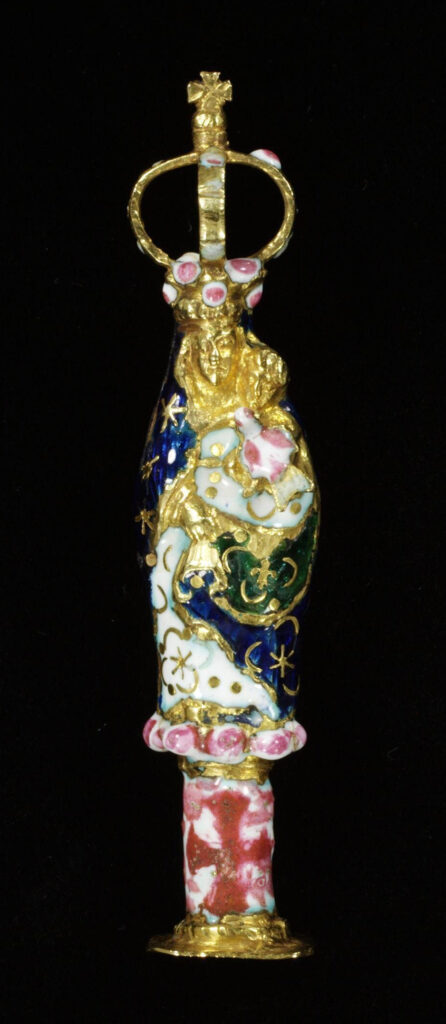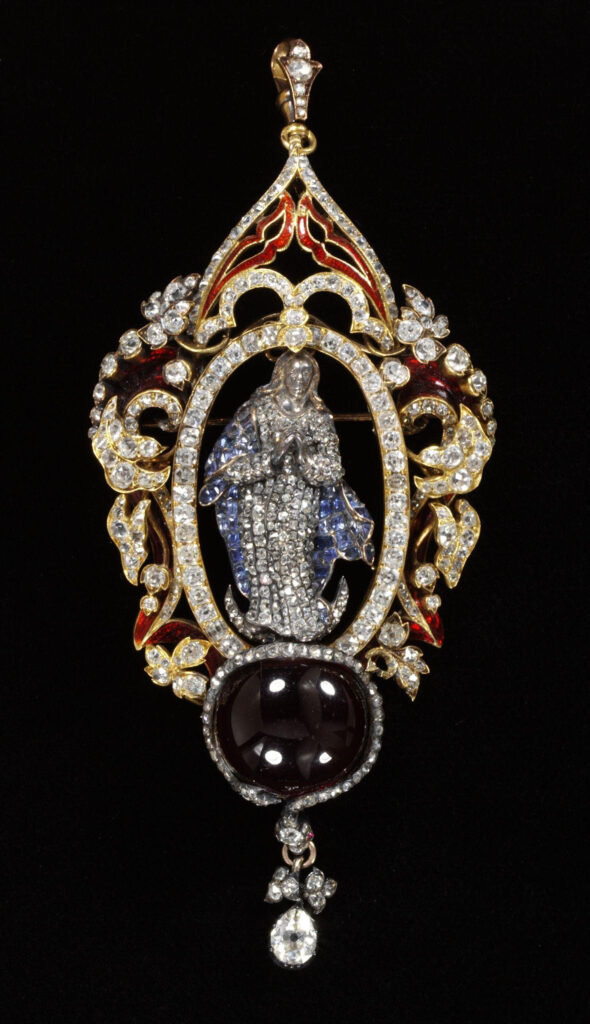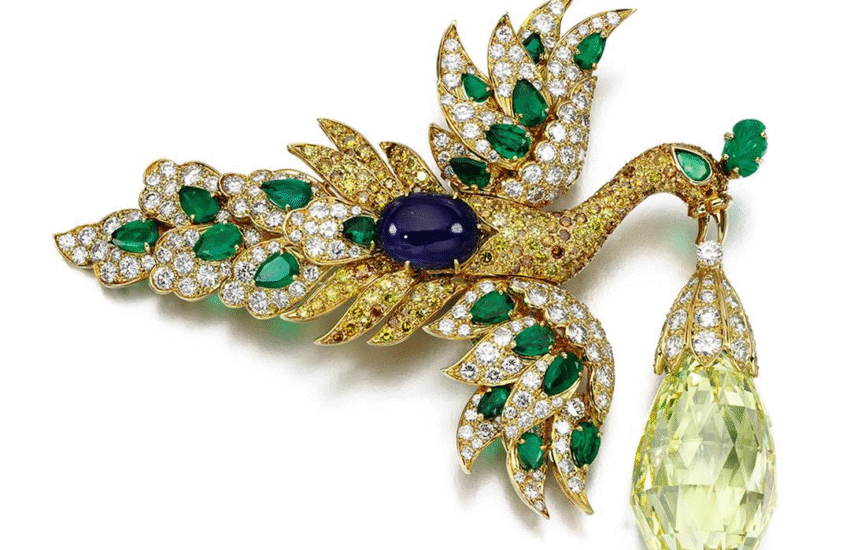M is for Moon: understanding symbolism in jewellery
To appreciate jewellery fully, it’s important to understand symbolism. In the alphabet of jewellery, M is for Moon, whether the full round moon or the delicate crescent. Jewels decorated with the moon are linked with the goddess of the hunt, Diana and with the Virgin Mary. They are used as love gifts and symbols of dreams. For the twentieth century maker, the moon was also the inspiration for space race jewellery and even formed the raw material of some jewels. Understanding the symbolism of the moon will unlock new meanings in some lovely historic jewels.
Diana, Artemis and Luna, goddesses of the moon
The Greek goddess Artemis and her Roman counterpart Diana, were associated with the moon and the hunt. According to the Roman author Cicero, Diana governed both life and death, growth and decline. Diana was sometimes shown wearing a crescent moon on her forehead, a fashion which was to reappear in nineteenth century jewellery.
Crescent moon amulets were worn in the ancient Greek and Roman world. They were described in Hesychius’s lexicon as a ‘crescent moon (selenis) – a protective amulet on the neck of children’. The Christian bishop of Caesarea, Basilius, disapproved of them as ‘moon-shaped plates of gold, silver or cheaper material which foolish old women fasten upon infants.’
1800 years ago, a young girl was buried in a cave in Roman period Israel. She was laid to rest wearing a gold necklace with one of these crescent moon jewels, the emblem of the moon goddess Luna. This was an amulet she would have worn in her life to protect her against the evil eye and all the dangers which afflicted children.

Queen Elizabeth I as Selene

Elizabeth I used the attributes of the moon goddesses Diana, Cynthia or Selene as part of her personal image making. She styled herself as the Virgin Queen, famously refusing to marry, and wore pearls which symbolised purity along with half-moon jewels. In the Rainbow Portrait at Hatfield House as well as this miniature by Nicholas Hillard, her hair is decorated with a diamond half-moon jewel. The jewel may also refer to Elizabeth’s status as the ruler of a powerful country with a navy that roamed the seas. Like the moon, Elizabeth governed the movements of the sea.
The Virgin Mary and the crescent moon
The Virgin Mary, mother of Jesus, was also associated with the moon. Like Artemis and Diana, Mary was a virgin and the moon a symbol of her purity. The Queen of Heaven is one of her incarnations, sometimes shown wearing a robe decorated with moon symbols, like this little pendant dating from around 1650.
The association of the Virgin with a crescent moon also reflects the vision of Saint John (Apocalypse 12:1): “a woman clothed in the sun, and the moon was under her feet.” The image of the Virgin standing on a crescent moon was a German iconographic design from the mid fifteenth century, which spread across Europe. It is found in sculpture, stained glass, paintings, prints and engravings as well as jewellery.
A jewel from around 1650 shows the Virgin standing on a crescent moon, with a larger crescent of crystals at her feet. The same design is repeated in a jewel from the mid nineteenth century. Also showing the Virgin on a diamond crescent moon, it was inspired by Renaissance designs. The diamond pendant from around 1850 was probably made for a Catholic wearer.
Finding faces in the moon
Humans have looked up at the the moon for millenia and created meanings from the patterns on its surface. Often the moon has been represented as a woman, perhaps an association between the changing phases of the moon and menstruation. Later eyes transformed the figure into the ‘man in the moon’ of our nursery rhymes.
The moon, our closest celestial neighbour, was a fascinating and changing element in the night sky. Medieval cosmologists were intrigued by lunar changes and their effect on human behaviour. ‘Lunaries’ or ‘moon books’ charted the phases of the moon and made predictions about its effect on human activities from birth to blood-letting. When the moon had an excessive influence, it could lead to madness, or literally, lunacy.
The woman/ man in the moon
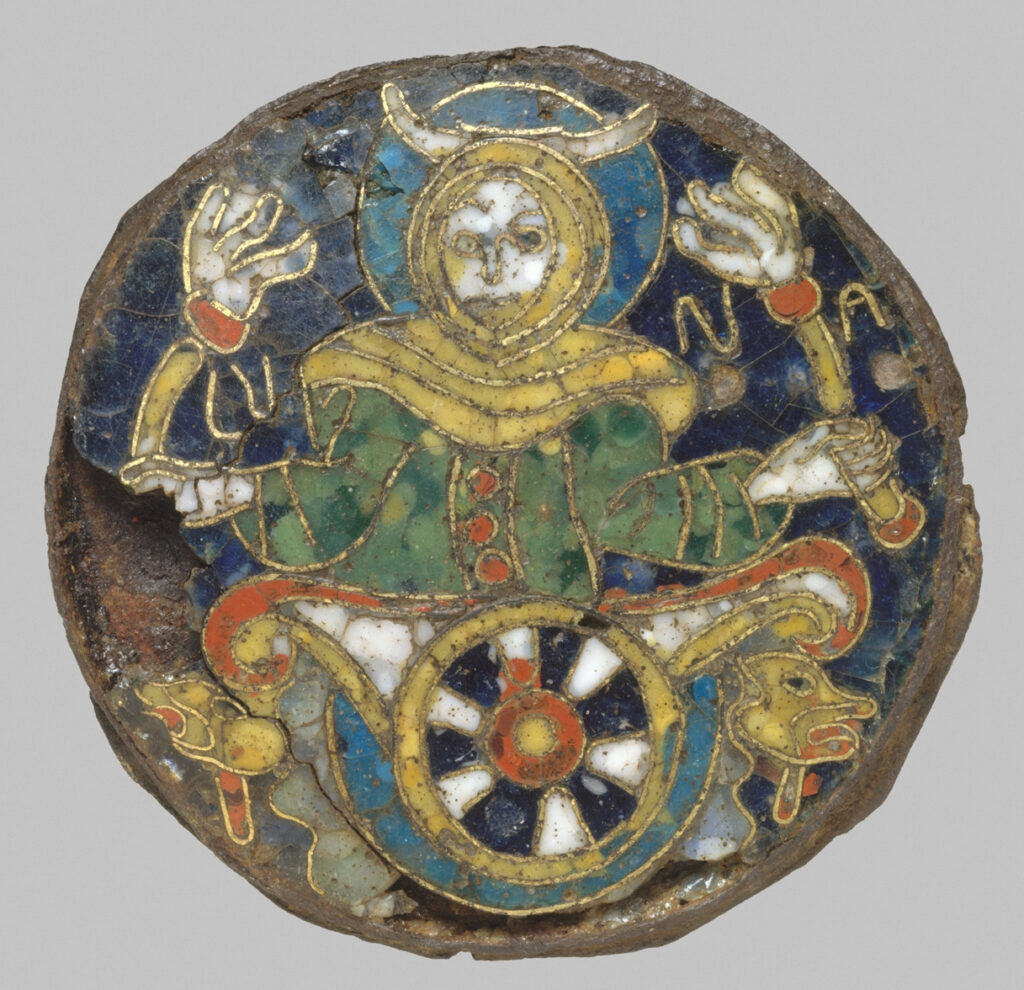
The moon is so close to us that we can see the patterns on its surface with a naked eye. These were sometimes interpreted as a human face, like the one in a lovely Carolingian enamelled roundel. It shows the moon as a woman riding in a chariot, holding a torch in each hand and wearing a crescent moon on her head. Originally made to decorate a crucifix, it may have been paired with a roundel to represent the sun. It was made in the late ninth century and is now in the Metropolitan Museum of Art, New York.
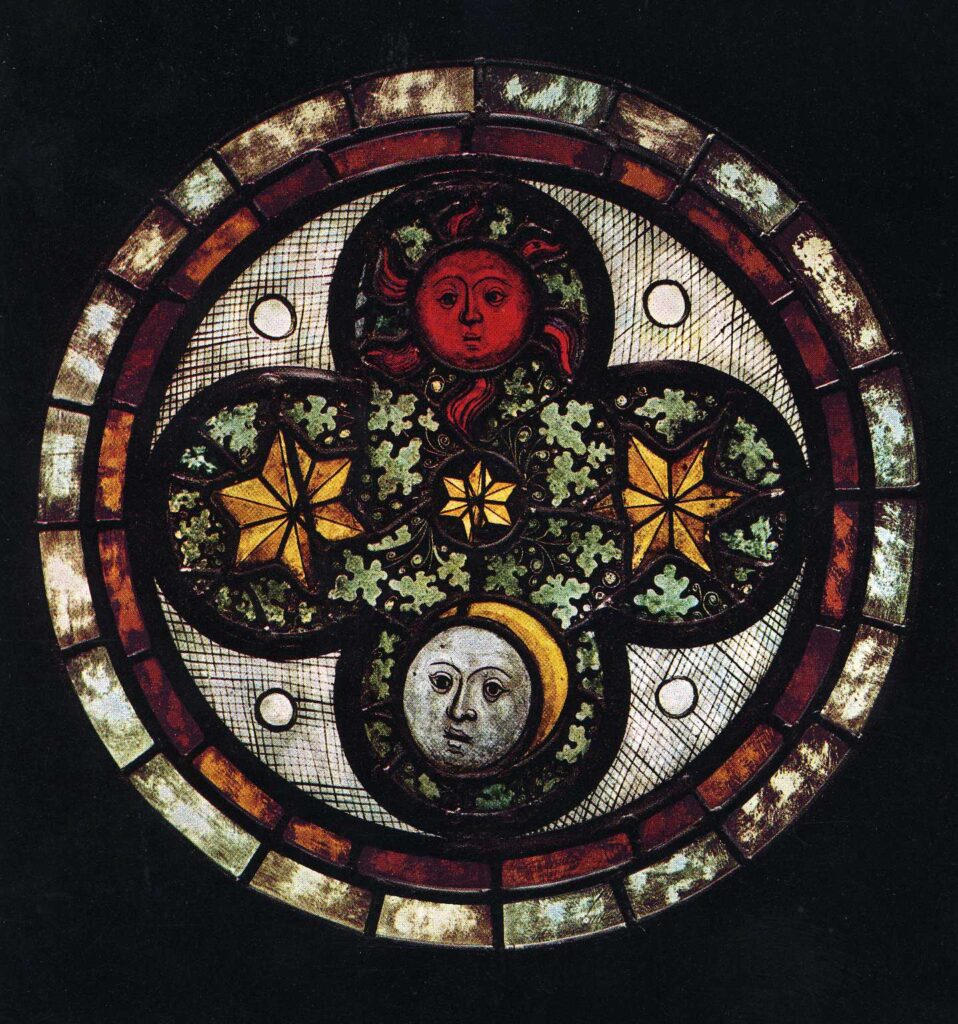
The notion of a moon with a human face can also be found in later medieval art. Centuries after the enamelled roundel, a stained glass panel made for the castle at Ebreichsdorf, Austria, around 1390. It shows the classic image of the ‘man in the moon’ although perhaps the face has no real gender?
Image from the Metropolitan Museum of Art, New York
Moon brooches
Lunar jewels appear in fashionable nineteenth century jewellery, sometimes as a face and sometimes as the elegant curved sickle moon.
Appropriately named, with its shiny translucent surface, moonstone was the perfect choice to carve out a lunar jewel. A little Victorian brooch, dated to around 1888, is a classic example. It shows a carved face in moonstone surrounded by a diamond crescent moon with a small diamond star perched on the top – maybe a shooting star?
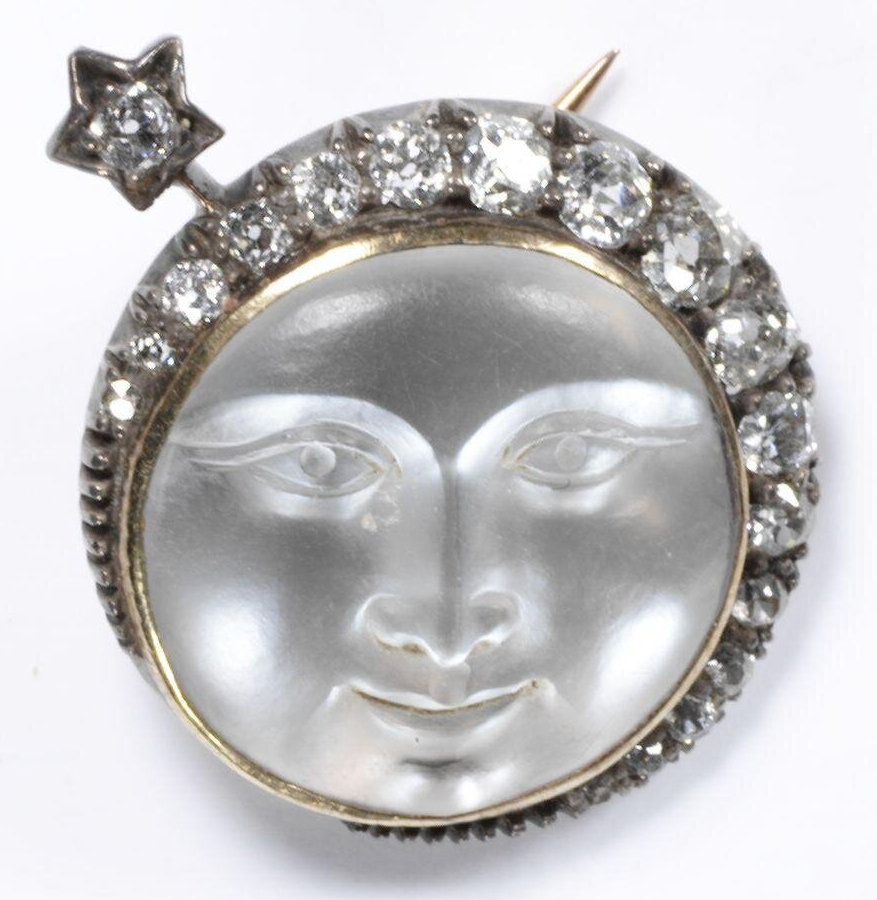
This design must have felt fresh and new. In 1893, The Sketch described:
a new diamond crescent-moon brooch; which forms a setting for the side face of the man in the moon, most cleverly cut from a moonstone, the luminous effect being really wonderful.
The Sketch, August 23, 1893
The description is almost identical to the moonstone and diamond brooch from the V&A.
Other fashion magazines also celebrated these lunar designs. In 1889, Harpers’ Bazaar listed them in their New York round-up of holiday gifts;
Diamond brooches, that serve also as pendants or hair ornaments, with evening toilettes, are rows of diamonds forming hollow hearts, true lovers’ knots, fleur de lis, the sun, moon, or stars…
Harper’s Bazaar, December 14 1889
The crescent moon in jewellery

Crescent or sickle moon jewels can be found in art and adverts in the late nineteenth century. The design was used in ‘New Moon’ brooches, appearing in an 1897 advert in The Graphic, alongside bows, lucky horseshoes and tiny swords.

A brooch from the late nineteenth century, set with a graduated row of brilliant cut diamonds shows how elegant these jewels could be. It has a pin fitting and an attachment for a hairpin or head-dress, so that it could be worn on the dress or in the hair.
Image: Victoria and Albert Museum
In Invitation to the Waltz, by Francesco Miralles Galaup, 1895 (Circulo del Liceo, Barcelona, Spain), an elegantly dressed young woman wears a large diamond crescent moon brooch pinned to the bodice of her pink silk dress. She is waiting patiently while a man writes his name on her dance card. The large brooch is the only jewel worn under her daringly bare neck and shoulders. Does the crescent moon hint at her identity as a young woman on the verge of marriage?

In this photograph from the 1880s to 90s by the Atelier Nadar, actor Lillie Langtry wears a diamond crescent jewel perched on the top of her curls. According to the Journal de Genève, February 23, 1888, many women wore crescrent moons inspired by Virginie Gautreau, famously painted as Madame X.
Lillie Langtry, ca. 1880s–90s. (Bibliothèque Nationale de France, Département Estampes et Photographie)
A scandalous Diana
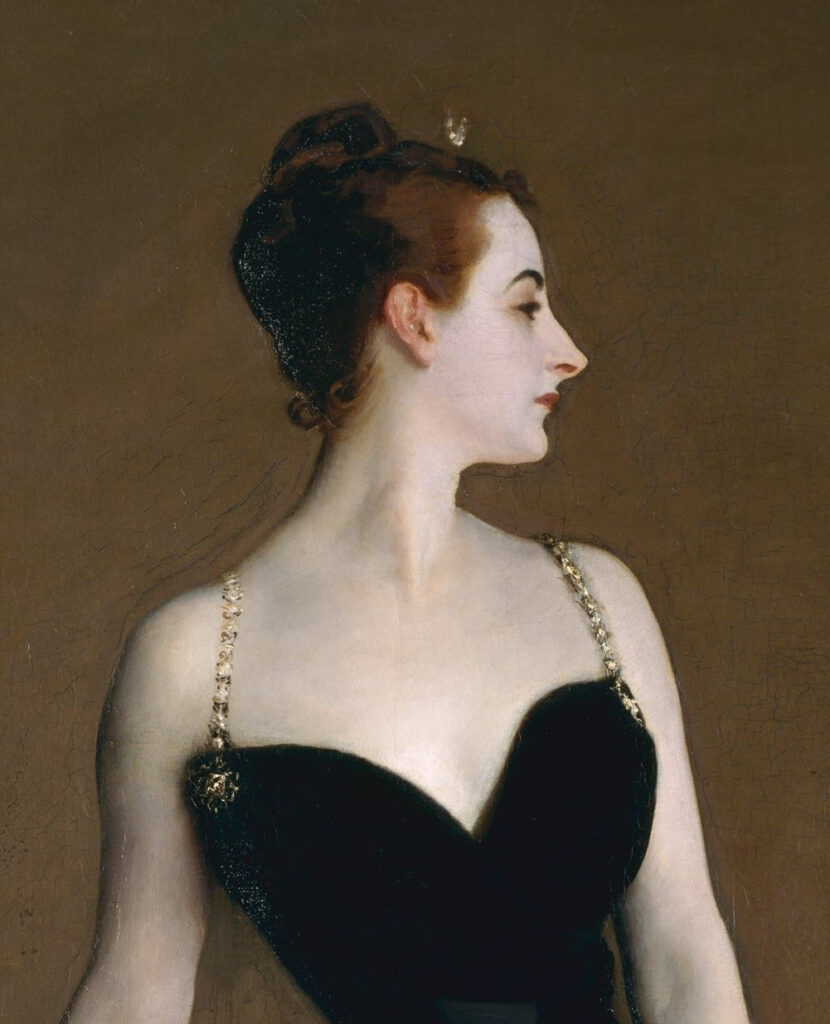
When John Singer Sargent painted his picture of Madame X in 1884, Virginie Gautreau also wore a crescent moon brooch. In her case, it was pinned to her head, like a modern day Diana and picks up the details of her jewelled dress straps.
The painting caused a scandal when it was shown. Although the title was anonymous, Virginie Gautreau was a beautiful and recognisable society woman. Showing her in a low cut dress, barely held up by slim straps, caused a commotion which she struggled to live down.
Image: Metropolitan Museum of Art, New York
As well as the simple moon shapes, Victorian shoppers could also buy the punning ‘honeymoon brooch’. A tiny gold bee symbolising honey, perched on a crescent moon, made a charming gift for the new bride.
Rabbits, rabbits, rabbits

The moon was much appreciated in Asian art, through moon viewing parties and in poetry.
In Japanese art, the moon is inhabited by a rabbit rather than a human, pounding sticky rice into rice cakes or mochi. A woodblock print by Katsushika Hokushū from 1819, ‘Rabbit in the snow beneath the moon’, uses the round shape of a white rabbit to echo that of the moon.

Although Japan didn’t have a strong tradition of personal jewellery, the moon rabbit can be found in little decorative dress accessories. A carved ivory netsuke, or toggle, from the eighteenth or nineteenth century shows a perky rabbit, with a pestle for pounding rice cakes, pushing against the moon.
Image: Science Museum Group
To the Moon!
By the nineteenth century, the moon was no longer just a space of imagination and contemplation. It was a real object which could be viewed through a telescope, photographed and perhaps, even one day, visited.
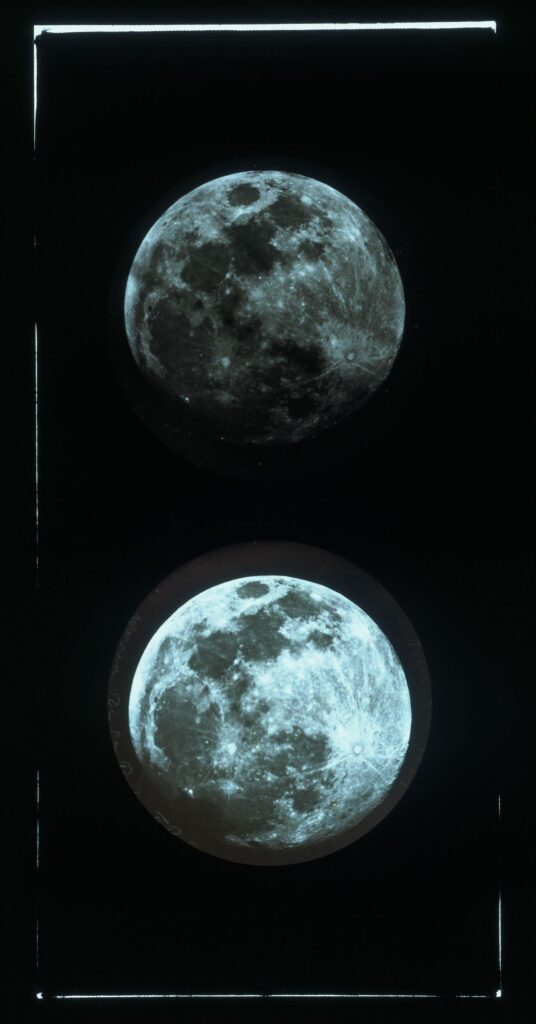
Warren de la Rue’s 1858 photographs of the moon show the surface in granular detail. Sadly, there were no faces and no rabbits but it was a great step forward for astronomers and scientists. The two images were made for a stereo viewer. Viewed together, they gave an illusion of three dimensionality. This fascination with the moon was also found in art, in Jules Verne’s novel From the earth to the moon or Jacques Offenbach’s 1875 opera, Le Voyage dans la Lune for which fantastical sets and costumes were made.
Image: Victoria and Albert Museum
The Space Race
The real Space Race, though, was in the 1950s and 60s. Feverish competition between the United States and the Soviet Union saw a series of firsts. The first animals went into space (often on a one-way ticket), followed by Yuri Gagarin, the first human to successfully orbit the earth in April 1961, followed by cosmonaut Valentina Tereshkova. She became the first woman in space in June 1963. And, of course, the Space Race was definitively won by the 1969 moon landing of Neil Armstrong, Buzz Aldrin and Michael Collins.

The excitement of space exploration, fuelled by feverish international competition, inspired space themed home decorations, fashion and of course, jewellery.
Jewels were inspired by the Apollo rocket, the Soviet Sputnik satellites and by the moon itself, newly revealed after the historic moon landing of 1969. The astronauts returned with samples of moon rock and photographs of the surface. Suddenly, the moon was a palpable physical reality.
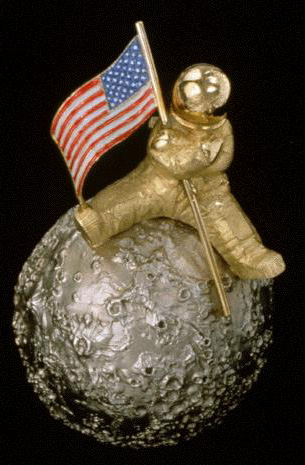
Belgian jeweller Freddy Wolfers approached the Space Race in the most literal way in the brooch he made for Pat Nixon in 1969. His brooch shows a triumphant American astronaut, holding a Stars and Stripes flag, sitting astride a silver, cratered moon. The brooch which Pat Nixon, wife of US president Richard Nixon, owned was one of a set of ten. Looking carefully at the brooch, we can see that the tip of the flagstaff rests on the Sea of Tranquillity, where Aldrin and Armstrong took the first ever steps on the moon.
Jackie Kennedy, a First Lady like Pat Nixon, owned a number of space themed jewels. Her second husband, Aristotle Onassis, commissioned a pair of circular Apollo earrings for her, from the jeweller Ilias Lalaounis. She also wore a pair of ‘Crater’ cuff bracelets by Van Cleef and Arpels.

The Parisian firm of Van Cleef and Arpels made a series of jewels inspired by the moon. They created a roughly textured gold ‘Moon Landing’ pendant in 1969, the surface bubbling with the craters of the newly revealed moon as well as Jackie Onassis’ cuff bracelets.
Image: Van Cleef and Arpels.

Fine jewellers used gold and gemstones to simulate the surface of the moon. The Moon Crater necklace was Roy King’s entry to the iconic 1961 Modern Jewellery Exhibition at London’s Goldsmiths’ Hall. Splashes of blue enamel suggest the shadows on the moon’s surface while the diamonds add glitter.
Modernist jewellers like Margaret de Patta, Ed Weiner, Henning Koppel, David Watkins and Björn Weckström followed suit, creating their own modern, stream-lined planetary jewels.
In conclusion
The moon has been an inspiration to jewellers for centuries. Whether as the attribute of the moon goddesses of the ancient world like Artemis and Diana, or the symbol of the Virgin Mary, it symbolised purity. For the nineteenth century woman, the moon could be an amusing ‘man in the moon’ brooch or a honeymoon pin. But it could also be worn as a glorious breast ornament or a head-pin to connect the wearer with Diana. Finally, by the twentieth century, the moon was an achievable destination, not just the preserve of dreamers and poets. The modern jeweller had photographic evidence of the moon’s surface to draw on, to make jewels which reflected the excitement of that extraordinary moment.

In the 2023 Korean drama, My Demon, the title character (played by actor Song Kang) shows off a silvery crescent moon brooch on his jacket. The look unites the fashion for male brooches, seen on so many red carpets and catwalks but also gives us a hint of the plot. Not only is he a supernatural creature, linked with the night, but his powers can only be regained at the full moon. The sliver of moon brooch is perhaps a foreshadowing of his coming fate but also shows the enduring appeal of the moon as a jewellery symbol.
From the classical world of Greece and Rome to contemporary k-drama, understanding the symbolism of the moon gives us a new way to look at jewellery and to appreciate the eternal appeal of the lunar.
Further reading
For more on jewellery symbolism, try A is for Anchor, B is for Butterfly, S is for Skull.
Edgar Williams, Moon: Nature and Culture, 2014

